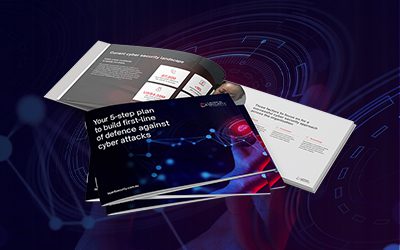The normal ways everyone is taught to identify Email Phishing attacks is to follow the following 10 tips:
Tip 1: Don’t trust the display name
A favourite phishing tactic among cybercriminals is to spoof the display name of an email.
Here’s how it works: If a fraudster wanted to spoof the hypothetical brand “My Bank,” the email may look something like:
Since My Bank doesn’t own the domain “secure.com,” DMARC will not block this email on My Bank’s behalf, even if My Bank has set their DMARC policy for mybank.com to reject messages that fail to authenticate. This fraudulent email, once delivered, appears legitimate because most user inboxes only present the display name. Don’t trust the display name. Check the email address in the header from—if looks suspicious, don’t open the email.
Tip 2: Look but don’t click
Hover your mouse over any links embedded in the body of the email. If the link address looks weird, don’t click on it. If you want to test the link, open a new window and type in website address directly rather than clicking on the link from unsolicited emails.
Tip 3: Check for spelling mistakes
Brands are pretty serious about email. Legitimate messages usually do not have major spelling mistakes or poor grammar. Read your emails carefully and report anything that seems suspicious.
Tip 4: Analyse the salutation
Is the email addressed to a vague “Valued Customer?” If so, watch out—legitimate businesses will often use a personal salutation with your first and last name.
Tip 5: Don’t give up personal information
Legitimate banks and most other companies will never ask for personal credentials via email. Don’t give them up.
Tip 6: Beware of urgent or threatening language in the subject line
Invoking a sense of urgency or fear is a common phishing tactic. Beware of subject lines that claim your “account has been suspended” or your account had an “unauthorized login attempt.”
Tip 7: Review the signature
Lack of details about the signer or how you can contact a company strongly suggests a phish. Legitimate businesses always provide contact details.
Tip 8: Don’t click on attachments
Including malicious attachments that contain viruses and malware is a common phishing tactic. Malware can damage files on your computer, steal your passwords or spy on you without your knowledge. Don’t open any email attachments you weren’t expecting.
Tip 9: Don’t trust the header from email address
Fraudsters not only spoof brands in the display name, but also spoof brands in the header from email address. Layer 8 Security found that nearly 30% of more than 760,000 email threats spoofed brands somewhere in the header from email address with more than two-thirds spoofing the brand in the email domain alone.
Tip 10: Don’t believe everything you see
Phishers are extremely good at what they do. Just because an email has convincing brand logos, language, and a seemingly valid email address, does not mean that it’s legitimate. Be sceptical when it comes to your email messages—if it looks even remotely suspicious, don’t open it.
Alternatively, you can:
The problem with phishing detection is that it requires focused attention to identify the components within the email.
Think about this scenario:
 You are driving down the road and a dog runs out in front of your car.
You are driving down the road and a dog runs out in front of your car.
Your cognitive brain, your conscious, identifies the dog but your subconscious does the braking and steering to avoid the dog.
Our cognitive brain has limited capabilities, and memory.
As we are all busy these days, expecting our conscious brain to not only identify the threat, but act upon it as well, is very difficult.
We teach people to identify only a small subset of item:
-
Is there a link to click?
-
Is there a file to download?
-
Are they after personal details?
If the answer to any of these is “Yes”, then stop and look deeper.
It helps to reduce the amount of work we expect our conscious brain to do whilst busy yet allows us to identify the threats.






